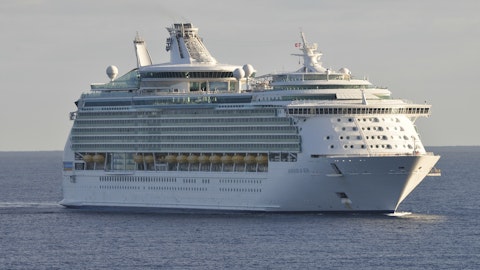Ira Birns: Yes, so there were two elements of weather. As you know, we have a bit of reliance in the U.K. on heating oil in the winter months and first quarter was a quarter where it was a lot warmer than we anticipated or remain warmer through the end of the quarter. Obviously, Investor Day was only two weeks before quarter end. But the weather conditions it continued through the end of March. On the domestic side, it was also probably — the impacts are probably from middle of the quarter through the end of the quarter on the nat gas side of the equation. There was — actually going back to the U.K., there was wet weather, also there was unseasonable amounts of rain, which impacted the agricultural segment, which we support in the U.K. So, there were several moving parts there, some of those continued into April.
But normally, the U.K. drops off seasonally when you get into May and June, which is going to be no different than we would normally see. And nat gas often drops off a bit as well as we head into, as we head into May and June. So, that’s why we signaled that Q2 for land will be pretty similar to the outcome in the first quarter. You’ll get — you get some more uptick in the liquid land business in North America, there’s some seasonal growth there. But a big chunk of that it’ll be offset by the seasonal decline in the U.K.
Ken Hoexter: And then just my last one, if I can just your thoughts on the SG&A comp and benefits G&A all wrapped-up, right, you’ve kind of been working on that for a few years, you talked about that a lot of Analyst Day in terms of what you can do, do you feel like you’re running as lean as you can on that? Or do you ever feel like there’s room–
Ira Birns: Never.
Ken Hoexter: All right, perfect.
Ira Birns: Never as lean as we can, but leaner than where we were. And we’re continuing to focus on — as we talked a lot about at Investor Day finding opportunities to be as efficient as possible across the board on the expense side. This quarter, we picked up some wins on G&A. Some of it is basic blocking and tackling some of it may be a little more complicated. The variable comp piece is more of — bit of timing, depending upon where results come through quarter-over-quarter. And as we go through the year, we’ll continue to look for more G&A opportunities, more opportunities to drive efficiencies across the board. That’s still work in progress and there’s definitely more work left to be done. And that’s why we’ve set a target well beyond where we finished off 2023 from a — from an operating leverage standpoint. And we’ll keep plugging away and keep reporting on our progress every quarter.
Ken Hoexter: Great. Appreciate the time. Thanks.
Operator: Thank you. [Operator Instructions] Our next question comes from the line of Pavel Molchanov from Raymond James.
Pavel Molchanov: Thanks for taking the question. So, standard question to start last year, low carbon was 11% of profitability. What was it this past quarter?
Ira Birns: 12% of gross profit this quarter that the — what we include in that basket of Kinect businesses. So, just up slightly.
Pavel Molchanov: Okay, perfect. Three months ago, one of the geopolitical headlines I suppose it’s been overtaken by other events, was the Red Sea and logistics bottlenecks and you had kind of a notable role in helping customers manage around that. Is that still something that needs to be managed? Or is the Red Sea issue in the rearview mirror?
Michael Kasbar: Pavel, thanks for the question. It’s extraordinary the resiliency of the marketplace and certainly shipping understands how to respond to disruptions. So, that’s settling out a bit. So, while there was impact to some extent and certainly that had material impact and still does on the fortunes of dry cargo and container and tanker, the impact in terms of the market coming together and sort of solving for that has settled down. So, not enormous impact. Got a little bit of a bump there, but that is pretty much settling down now.
Pavel Molchanov: Let me ask another kind of maybe more big picture question, one of the hot topics of conversation recently has been the prospect of meaningful growth in electricity demand on both sides of the Atlantic, driven by AI and data centers, obviously not transport related specifically by given your kind of broadening into the electric power space. I’m curious how you’re thinking about that and what kinds of customer conversations this is generating.
Michael Kasbar: It’s real. AI — the compute required is significant and the energy demand associated with that is real. And there’s a general increase in just power consumption. So, that certainly bodes well for our growing competencies within all aspects of the power side. So, whether it’s development-as-a-service for hydrogen power to x, solar, wind, offshore wind, its impact on the demand for marine solutions. So, all of that bodes well for our products and services and our positioning, whether it’s our advisory or brokerage, every single part of the span of that power demand, really maps to what we do. So, in terms of where it’s going from a macro perspective, that’s obviously a bigger question. That’s not something that we need to solve. But certainly we are within that arena and play a role in satisfying any number of those dimensions to that increased demand.
Pavel Molchanov: Got it. Thank you very much.
Operator: Thank you. At this time, I would now like to turn the conference back over to Michael Kasbar for closing remarks.
Michael Kasbar: Well, just want to thank our suppliers, customers, and investors for your support and partnership, and to all of our teammates around the world, thank you for what you do every day. We enjoy working, we enjoy and love what we do. So, have a great and safe day and look forward to talking to you next quarter. Take care. Stay safe. Be well.
Operator: This concludes today’s conference call. Thank you for participating. You may now disconnect.
Follow World Kinect Corp (NYSE:WKC)
Follow World Kinect Corp (NYSE:WKC)
Receive real-time insider trading and news alerts




